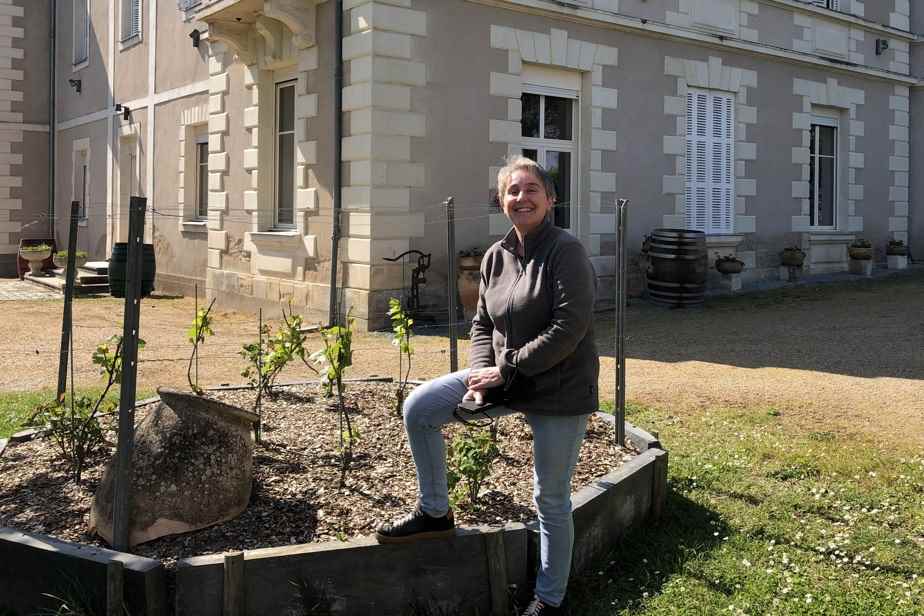(Rochefort-sur-Loire) Who would have thought that chenin blanc, typical of Loire wines, had several similarities with vidal, a hybrid widespread in Quebec? This is what Laëtitia Huet believes. The winemaker spent 12 years at the Rivière-du-Chêne vineyard in Saint-Eustache before buying a chateau in the Loire. She is now inspired by Quebec to develop her wines.
Posted at 11:00 a.m.
The harvest is well underway south of the town of Angers, in the Loire Valley. The tractors are busy in the countryside and the vineyards have temporarily closed their doors for harvest time.
However, at the Château de Piéguë, visitors are welcome. Every Saturday in September, winemaker Laëtitia Huet welcomes 25 people for a day of immersion in the hillsides of Layon.
This concept, still not widespread in France, is reminiscent of the harvest days organized in vineyards in Quebec. It is also a well-established activity at the Rivière-du-Chêne estate, in Saint-Eustache, where Laëtitia Huet worked for 12 years.
“Customers love it,” she observes. We are always full. We harvest in the morning, then we eat together at noon before transforming the fruits in the afternoon. This is exactly what we did in Rivière-du-Chêne. »
The day of immersion in the harvests is not the only inspiration that the winemaker has brought back from Quebec. The Loire Valley is shaken by climate change.
To combat spring frosts, which are increasingly frequent and devastating in this region of France, producers are installing wind towers. A machine that we have seen for a long time in the Quebec landscape.
Still others are testing protection with geotextile fabrics. These methods, Laëtitia Huet knows them by heart, since she has used them for a long time in Quebec.
Hybrids to the rescue
The winegrower, however, has another solution in mind to fight the frost: planting hybrids. Vidal, one of the most common white grapes in the province, is in his sights. Its resemblance to the star grape of the Loire, Chenin Blanc, is striking.
“The texture of the bunch, the thick skin, the strong acidity… Chenin Blanc and Vidal have a lot of similarities. »
Like Chenin, Vidal is very versatile. It makes it possible to produce sparkling wines, dry and sweet whites. Its real asset for the Loire lies in its buds which come out later in the spring, and which are therefore less likely to be exposed to frost.
The vidal was created at the beginning of the XXe century to fight phylloxera in Europe, but it was quickly despised, like the other hybrids. Climate change could, however, give it a second life on the European continent, as more and more hybrids are being tested in France.
Too expensive in Quebec
The valleys bordering the Layon river are linked to the south of the city of Angers. The castles of the Loire, built of white tufa stone, stand in a setting of green vines. The cypresses and umbrella pines that surround Château Piéguë even evoke a Tuscan landscape.
However, it is not this idyllic setting that prompted Laëtitia Huet to return to France. After a decade, she had mastered the vinification of capricious hybrids and appreciated the harsher climate. With her husband, she visited several vineyards for sale in Quebec before concluding that it would be easier to make a profitable estate in France.
Vineyards are super expensive in Quebec and there is a lot of risk involved. It remains a challenge to make wine in Quebec, versus in France, where the terroir is easier.
Laëtitia Huet, winemaker
Is a Château de la Loire, bordered by 28 hectares of mature vines, more affordable than a vineyard in Dunham? Not really. Nine shareholders, including three Quebecers, believed in Laëtitia Huet’s dream and helped her finance the purchase. The winegrower also operates guest rooms in the large residence.
While waiting for her first wine, a Crémant de Loire, to hit SAQ shelves in November, the winemaker proudly displays in her tasting room a photo taken in Quebec while harvesting frozen grapes covered in snow one month of December.
Tasting Note
Chardonnay and Chenin Blanc are equally divided into the blend of this Crémant de Loire. After aging on lees for a minimum of 18 months, freshness and finesse of the bubble are there. Scents of green almond and lemon perfume the glass. The refreshing attack quickly gives way to a rounder and more indulgent texture. Subtly dosed, without being completely dry, it is a magnificent sparkling wine to accompany oysters.

PHOTO PROVIDED BY THE CASTLE OF PIEGUË
Château Pieguë, Crémant de Loire
Château Piéguë, Crémant de Loire, $25.05 (15046141). It will be offered at the SAQ in November.

